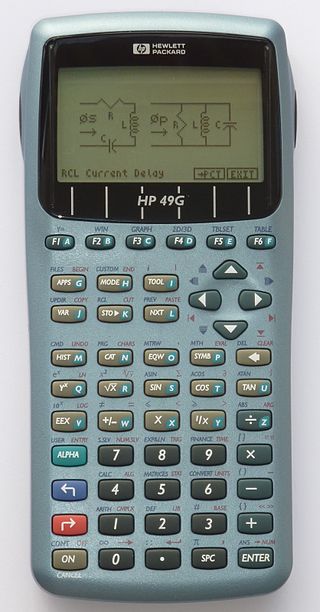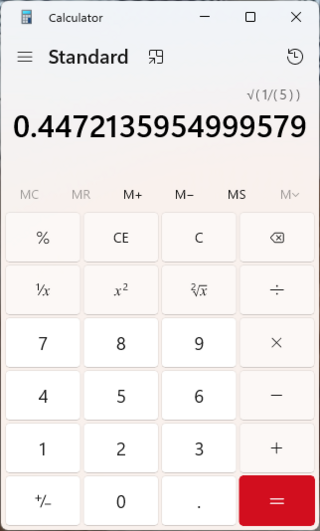In computing, cross-platform software is computer software that is designed to work in several computing platforms. Some cross-platform software requires a separate build for each platform, but some can be directly run on any platform without special preparation, being written in an interpreted language or compiled to portable bytecode for which the interpreters or run-time packages are common or standard components of all supported platforms.

The HP 49/50 series are Hewlett-Packard (HP) manufactured graphing calculators. They are the successors of the popular HP 48 series.

A graphing calculator is a handheld computer that is capable of plotting graphs, solving simultaneous equations, and performing other tasks with variables. Most popular graphing calculators are programmable calculators, allowing the user to create customized programs, typically for scientific, engineering or education applications. They have large screens that display several lines of text and calculations.

The SWORD Project is the CrossWire Bible Society's free software project. Its purpose is to create cross-platform open-source tools—covered by the GNU General Public License—that allow programmers and Bible societies to write new Bible software more quickly and easily.

The TI-84 Plus is a graphing calculator made by Texas Instruments which was released in early 2004. There is no original TI-84, only the TI-84 Plus, the TI-84 Plus Silver Edition models, and the TI-84 Plus CE. The TI-84 Plus is an enhanced version of the TI-83 Plus. The key-by-key correspondence is relatively the same, but the TI-84 features improved hardware. The archive (ROM) is about 3 times as large, and the CPU is about 2.5 times as fast. A USB port and built-in clock functionality were also added. The USB port on the TI-84 Plus series is USB On-The-Go compliant, similar to the next generation TI-Nspire calculator, which supports connecting to USB based data collection devices and probes, and supports device to device transfers over USB rather than over the serial link port.

Windows Calculator is a software calculator developed by Microsoft and included in Windows. In its Windows 10 incarnation it has four modes: standard, scientific, programmer, and a graphing mode. The standard mode includes a number pad and buttons for performing arithmetic operations. The scientific mode takes this a step further and adds exponents and trigonometric function, and programmer mode allows the user to perform operations related to computer programming. In 2020, a graphing mode was added to the Calculator, allowing users to graph equations on a coordinate plane.

NASA WorldWind is an open-source virtual globe. According to the website, "WorldWind is an open source virtual globe API. WorldWind allows developers to quickly and easily create interactive visualizations of 3D globe, map and geographical information. Organizations around the world use WorldWind to monitor weather patterns, visualize cities and terrain, track vehicle movement, analyze geospatial data and educate humanity about the Earth." It was first developed by NASA in 2003 for use on personal computers and then further developed in concert with the open source community since 2004. As of 2017, a web-based version of WorldWind is available online. An Android version is also available.

Mathomatic is a free, portable, general-purpose computer algebra system (CAS) that can symbolically solve, simplify, combine and compare algebraic equations, and can perform complex number, modular, and polynomial arithmetic, along with standard arithmetic. It does some symbolic calculus (derivative, extrema, Taylor series, and polynomial integration and Laplace transforms), numerical integration, and handles all elementary algebra except logarithms. Trigonometric functions can be entered and manipulated using complex exponentials, with the GNU m4 preprocessor. Not currently implemented are general functions like f(x), arbitrary-precision and interval arithmetic, and matrices.
Google Developers is Google's site for software development tools and platforms, application programming interfaces (APIs), and technical resources. The site contains documentation on using Google developer tools and APIs—including discussion groups and blogs for developers using Google's developer products.

The TI-Nspire is a graphing calculator line made by Texas Instruments, with the first version released on 25 September 2007. The calculators feature a non-QWERTY keyboard and a different key-by-key layout than Texas Instruments's previous flagship calculators such as the TI-89 series.
Panda3D is a game engine that includes graphics, audio, I/O, collision detection, and other abilities relevant to the creation of 3D games. Panda3D is free, open-source software under the revised BSD license.
Enthought, Inc. is a software company based in Austin, Texas, United States that develops scientific and analytic computing solutions using primarily the Python programming language. It is best known for the early development and maintenance of the SciPy library of mathematics, science, and engineering algorithms and for its Python for scientific computing distribution Enthought Canopy.

MIT App Inventor is a high-level block-based visual programming language, originally built by Google and now maintained by the Massachusetts Institute of Technology. It allows newcomers to create computer applications for two operating systems: Android and iOS, which, as of 25 September 2023, is in beta testing. It is free and open-source released under dual licensing: a Creative Commons Attribution ShareAlike 3.0 Unported license and an Apache License 2.0 for the source code. Its target is primarily children and students studying computer programming, similar to Scratch.

Adafruit Industries is an open-source hardware company based in New York, United States. It was founded by Limor Fried in 2005. The company designs, manufactures and sells electronics products, electronics components, tools, and accessories. It also produces learning resources, including live and recorded videos about electronics, technology, and programming.

LineageOS is an Android-based operating system for smartphones, tablet computers, and set-top boxes, with mostly free and open-source software. It is the successor to CyanogenMod, from which it was forked in December 2016, when Cyanogen Inc. announced it was discontinuing development and shut down the infrastructure behind the project. Since Cyanogen Inc. retained the rights to the Cyanogen name, the project rebranded its fork as LineageOS.

CircuitPython is an open-source derivative of the MicroPython programming language targeted toward students and beginners. Development of CircuitPython is supported by Adafruit Industries. It is a software implementation of the Python 3 programming language, written in C. It has been ported to run on several modern microcontrollers.
Microsoft, a technology company historically known for its opposition to the open source software paradigm, turned to embrace the approach in the 2010s. From the 1970s through 2000s under CEOs Bill Gates and Steve Ballmer, Microsoft viewed the community creation and sharing of communal code, later to be known as free and open source software, as a threat to its business, and both executives spoke negatively against it. In the 2010s, as the industry turned towards cloud, embedded, and mobile computing—technologies powered by open source advances—CEO Satya Nadella led Microsoft towards open source adoption although Microsoft's traditional Windows business continued to grow throughout this period generating revenues of 26.8 billion in the third quarter of 2018, while Microsoft's Azure cloud revenues nearly doubled.











